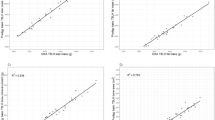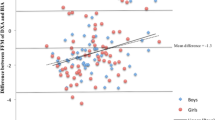Abstract
In vivo precision for body composition measurements using dual energy X-ray absorptiometry (DXA; GE Lunar iDXA, GE Healthcare, Bucks, UK) was evaluated in 52 men and women, aged 34.8 (s.d. 8.4; range 20.1–50.5) years, body mass index (25.8 kg/m2; range 16.7–42.7 kg/m2). Two consecutive total body scans (with re-positioning) were conducted. Precision was excellent for all measurements, particularly for total body bone mineral content and lean tissue mass (root mean square 0.015 and 0.244 kg; coefficients of variation (CV) 0.6 and 0.5%, respectively). Precision error was CV 0.82% for total fat mass and 0.86% for percentage fat. Precision was better for gynoid (root mean square 0.397 kg; CV 0.96%) than for android fat distribution (root mean square 0.780 kg, CV 2.32%). There was good agreement between consecutive measurements for all measurements (slope (s.e.) 0.993–1.002; all R2=0.99). The Lunar iDXA provided excellent precision for total body composition measurements. Research into the effect of body size on the precision of DXA body fat distribution measurements is required.
This is a preview of subscription content, access via your institution
Access options
Subscribe to this journal
Receive 12 print issues and online access
$259.00 per year
only $21.58 per issue
Buy this article
- Purchase on Springer Link
- Instant access to full article PDF
Prices may be subject to local taxes which are calculated during checkout
Similar content being viewed by others
References
Baim S, Blinkley N, Bilezikian L, Kendler DL, Hans DB, Lewiecki EM (2008). Official positions of the International Society for Clinical Densitometry and executive summary of the 2007 position development conference. J Clin Densitom 11, 75–79.
Berends AL, Zillikens MC, de Groot CJ, Rivadenera F, Oostrie BA, van Duijin CM (2009). Body composition by dual energy X-ray absorptiometry in women with previous pre-eclampsia or small for gestational age offspring. BJOG 116, 442–445.
Economos CD, Nelson ME, Fiaterone MA, Dallal GE, Heymsfield SB, Wang J et al. (1997). A multi-centre comparison of dual energy X-ray absorptiometers: in vivo and in vitro soft tissue measurement. Eur J Clin Nutr 51, 312–317.
Faulkner KG, Deman PR, Wacker KP, Riewe KP, Franze JR, Barden HS (2006). Accuracy and precision of the Lunar iDXA, a new fan beam densitometer. ECTS conference proceedings, presentation. P374.
Figueroa-Colon R, Mayo MS, Treuth MS, Aldridge RA, Weinscen RC (1998). Reproducibility of DXA measurements in prepubertal girls. Obes Res 6, 262–267.
Irwin ML, Alvarez-Reeves M, Cadmus L, Mierzejewski E, Mayne ST, Yu H (2009). Exercise improves body fat, lean mass, and bone mass in breast cancer survivors. Obesity 17, 1534–1541.
Krueger DM, Checovich N, Vallarta-Ast D, Gemar D, Blinkley N (2006). Comparison of total body parameters as measured using GE Healthcare Lunar Prodigy and Lunar iDXA densitometers. J Bone Mineral Res 21, SS225.
Lee K, Lee S, Kim Y, Kim Y (2008). Waist circumference, dual energy X-ray absorptiometry measured abdominal adiposity, and computed tomographically-derived intra-abdominal fat area on detecting metabolic risk factors in obese women. Nutrition 24, 625–631.
Madsen OR, Jenson JE, Sorenson OH (1997). Validation of a dual energy X-ray absorptiometer: measurement of bone mass and soft tissue composition. Eur J Appl Physiol Occup Physiol 75, 554–558.
Oldroyd B, Smith AH, Truscott JG (2003). Cross calibration of GE/Lunar pencil and fan beam dual energy densitometers – bone mineral density and body composition studies. Eur J Clin Nutr 57, 977–987.
Piche ME, Lapointe A, Weisnagel SJ, Corneau L, Nadeau A, Bergeron J et al. (2008). Regional body fat distribution and metabolic profile in postmenopausal women. Metabolism 57, 1101–1107.
Rezzi S, Ginty F, Beaumont A (2009). Body composition precision with the Lunar iDXA. ISCD Meeting Proceedings; March 2009; Orlando, FL, USA.
Toussinot E, Semon C, Penfornis F, Windling D (2007). Body composition measurements with Lunar iDXA: Precision evaluation. J Bone Miner Res 22 (T281), S300.
Uusi-Rasi K, Rauhio A, Kannus P, Pasanen M, Kukkanen-Harjula K, Fogelman M et al. (2009). Three-month weight reduction does not compromise bone strength in obese premenopausal women. Bone 46: 1286–1293.
Author information
Authors and Affiliations
Corresponding author
Ethics declarations
Competing interests
The authors declare no conflict of interest.
Rights and permissions
About this article
Cite this article
Hind, K., Oldroyd, B. & Truscott, J. In vivo precision of the GE Lunar iDXA densitometer for the measurement of total body composition and fat distribution in adults. Eur J Clin Nutr 65, 140–142 (2011). https://doi.org/10.1038/ejcn.2010.190
Received:
Revised:
Accepted:
Published:
Issue Date:
DOI: https://doi.org/10.1038/ejcn.2010.190
Keywords
This article is cited by
-
Preventing the adverse cardiovascular consequences of allogeneic stem cell transplantation with a multi-faceted exercise intervention: the ALLO-Active trial protocol
BMC Cancer (2022)
-
Reproducibility of total and regional body composition using dual-energy X-ray absorptiometry in rheumatoid arthritis and ankylosing spondylitis
Osteoporosis International (2021)
-
The effect of central obesity on inflammation, hepcidin, and iron metabolism in young women
International Journal of Obesity (2020)
-
The impact of vitamin D supplementation on VDR gene expression and body composition in monozygotic twins: randomized controlled trial
Scientific Reports (2020)
-
Muscle quality as a complementary prognostic tool in conjunction with sarcopenia assessment in younger and older individuals
European Journal of Applied Physiology (2019)



